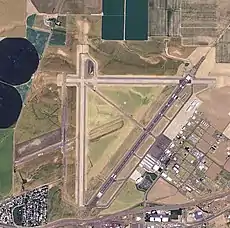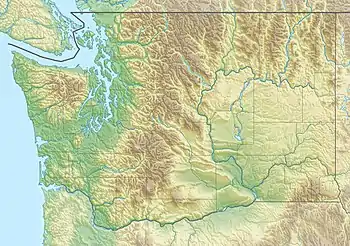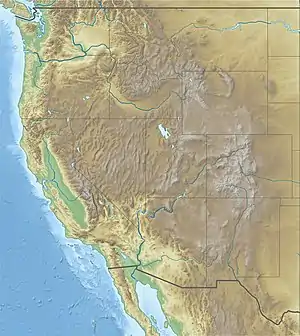Walla Walla Regional Airport
Walla Walla Regional Airport (IATA: ALW, ICAO: KALW, FAA LID: ALW) is a public airport in Walla Walla County, Washington, in the western United States. It is three miles (5 km) northeast of central Walla Walla, and is owned by the Port of Walla Walla.[1]
Walla Walla Regional Airport Walla Walla Army Air Base | |||||||||||
|---|---|---|---|---|---|---|---|---|---|---|---|
 2006 USGS Orthophoto | |||||||||||
| Summary | |||||||||||
| Airport type | Public | ||||||||||
| Owner | Port of Walla Walla | ||||||||||
| Serves | Walla Walla, Washington | ||||||||||
| Location | Walla Walla County, Washington, U.S. | ||||||||||
| Elevation AMSL | 1,194 ft / 364 m | ||||||||||
| Coordinates | 46.09°N 118.29°W | ||||||||||
| Map | |||||||||||
 ALW Location of airport in Washington / United States  ALW ALW (USA West) | |||||||||||
| Runways | |||||||||||
| |||||||||||
| Statistics (2017) | |||||||||||
| |||||||||||
History
World War II
The airport was the location of the U.S. Army Air Forces' Walla Walla Army Air Base in World War II.[2]
The War Department announced it would be spending more than $7.5 million to construct an Army Air Corps training airfield adjacent to the existing airfield at Walla Walla. With the old 200-acre (0.8 km2) municipal airport as a nucleus, it commenced development of the Walla Walla Army Air Base, which ultimately comprised 2,164 acres (8.8 km2) of land. Over 300 buildings were constructed and equipped to house, feed, and train approximately 6,000 personnel.
The 91st Bomb Group was the first Army Air Forces outfit to utilize the Walla Walla base. The 91st had initially trained in Florida, and upon arrival trained in B-17 Flying Fortress four-engine bombers. The 91st went on to distinguish itself in combat over Europe. Several of these crews made outstanding records during their tour of duty and were well publicized upon their return to the United States, with names such as Delta Rebel, Jack the Ripper, and Memphis Belle, the first B-17 to complete 25 missions in Europe.
Late in 1943, the airfield lay idle when the Second Air Force withdrew its B-17 training operation.[3] In April 1944, the Fourth Air Force took charge and established a training base for B-24 Liberator bomber crews.[4]
During the war years, it is estimated that more than 8,000 officers and men were trained at this base producing 594 heavy bomber crews who compiled about 114,514 hours in the air while in training. One of its aircraft crashed in September 1944 at the future site of the Mission Ridge ski area near Wenatchee, killing all six aboard;[5][6] a wing section from the B-24 is mounted above its "Bomber Bowl."[6]
Post-war
In 1947, the newly-formed U.S. Air Force declared the airfield as surplus and the city and county took over operations on December 1. A board was formed to manage the airport and the complexities of the facilities transfer. After considerably less than the standard two-year probationary period, the airport board received an approved Civil Aeronautics Authority's full and complete title to the $13 million airport on April 10, 1949. This was the first joint ownership (city/county) permitted in the entire nation.[7]
In 1965, the airport was a USAF dispersal base for fighter-interceptors of Air Defense Command, manned by the 325th Fighter Wing of McChord AFB, near Tacoma. Walla Walla was previously part of the 337th Fighter Group of Portland, Oregon.[8]
In 1989, the Port of Walla Walla took over ownership and operational responsibility of the airport from the city and county of Walla Walla. The airport is mostly used for general aviation but is also served by one commercial airline.
The former office and supply buildings surrounding the airport proper have become a haven for smaller industrial/manufacturing businesses, including, as of June 2007, 15 full-line wineries that source their fruit from the Walla Walla and Columbia Valley appellations. The Port of Walla Walla recently completed a "wine incubator" project; three specially-constructed buildings that are leased on non-renewable six-year contracts to fledgling wineries. Among the 20 plus wineries with primary operations at the Walla Walla Regional Airport are Dunham Cellars, Tamarack Cellars, Buty Wines, Syzygy Winery, Revelry Vintners, Five Star Cellars, and Stephenson Cellars.
Facilities and aircraft
Walla Walla Regional Airport covers an area of 2,319 acres (9.38 km2) which includes one concrete/grooved runway: 2/20 measuring 6,527 by 150 feet (1,989 m × 46 m).[1] There is a VOR on the field that operates on 116.4 MHz.
For the 12-month period ending January 1, 2018, the airport had 28,206 aircraft operations, an average of 77 per day: 92% general aviation, 4% air taxi, 3% scheduled commercial and <1% military. At that time there were 88 aircraft based at this airport: 88 single-engine, 4 multi-engine, 1 helicopter, 4 ultralight and 1 glider.[1] Walla Walla Regional Airport has 19 scheduled commercial roundtrip flights to Seattle each week.[9]
Walla Walla University and Skyrunners Corporation operate flight schools on the field, from primary training through multi-engine, commercial, and other training.
Airlines and destinations
Passenger
| Airlines | Destinations |
|---|---|
| Alaska Airlines | Seattle/Tacoma |
Cargo
| Airlines | Destinations |
|---|---|
| Ameriflight | Pasco, Seattle–Boeing, Yakima |
Top destinations
| Rank | City | Passengers | Carriers |
|---|---|---|---|
| 1 | Seattle/Tacoma, WA | 33,040 | Alaska |
Historical airline service
Walla Walla had scheduled passenger jet service in the past provided by West Coast Airlines, which operated Douglas DC-9-14 jetliners, and also by Cascade Airways, which flew British Aircraft Corporation BAC One-Eleven twinjets. Both airlines also operated turboprop aircraft into the airport as well. West Coast flew Fairchild F-27 propjets while Cascade operated Hawker Siddeley HS 748, Beechcraft 1900C and Fairchild Swearingen Metroliner turboprops. In addition, Cascade had its major maintenance base located at the airport for all of the aircraft types it operated including the BAC One-Eleven jets.
West Coast then merged with Bonanza Air Lines and Pacific Air Lines to form Air West, which was subsequently renamed Hughes Airwest. Both Air West and Hughes Airwest continued to serve Walla Walla with Fairchild F-27 propjet flights, although by 1975 Hughes Airwest had turned over all of its service to Cascade Airways.
Currently, Horizon Air operates Bombardier Q400 propjets into Walla Walla on behalf of Alaska Airlines. The Q400 is the latest, largest, and fastest member of the Dash 8 family of turboprop aircraft.
References
![]() This article incorporates public domain material from the Air Force Historical Research Agency website http://www.afhra.af.mil/.
This article incorporates public domain material from the Air Force Historical Research Agency website http://www.afhra.af.mil/.
- FAA Airport Form 5010 for ALW PDF, effective 2007-12-20
- History of the Walla Walla District, Corps of Engineers
- "Walla Walla base to new command". Spokane Daily Chronicle. (Washington). December 31, 1943. p. 3.
- "Fourth Air Force strength to be boosted, Army says". Spokane Daily Chronicle. (Washington). March 25, 1944. p. 1.
- "Bomber crashes near Wenatchee". Ellensburg Daily Record. (Washington). Associated Press. October 2, 1944. p. 1.
- "Snow comes". Ellensburg Daily Record. (Washington). Associated Press. November 13, 1992. p. 13.
- Walla Walla Regional Airport & Industrial Park
- "325th Fighter Wing takes over". Spokesman-Review. (Spokane, Washington). September 26, 1965. p. 21.
- "Flight Schedule". Walla Walla Regional Airport. Retrieved 6 January 2018.
- http://www.transtats.bts.gov/airports.asp?pn=1&Airport=ALW&Airport_Name=Walla Walla, WA: Walla Walla Regional&carrier=FACTS
External links
- Walla Walla Regional Airport, official site
- Walla Walla Regional Airport at WSDOT Aviation
- FAA Airport Diagram (PDF), effective January 28, 2021
- FAA Terminal Procedures for ALW, effective January 28, 2021
- Resources for this airport:
- AirNav airport information for KALW
- ASN accident history for ALW
- FlightAware airport information and live flight tracker
- NOAA/NWS weather observations: current, past three days
- SkyVector aeronautical chart for KALW
- FAA current ALW delay information
